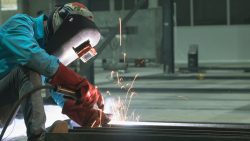How Steel Fabrication Techniques Influence the Strength of Bollards
April 28, 2023 3:24 pm Leave your thoughts How Steel Fabrication Techniques Influence the Strength of Bollards
How Steel Fabrication Techniques Influence the Strength of Bollards
Bollards are used to protect buildings, pedestrians and vehicles from accidental collisions. Bollards are commonly found in parking lots, sidewalks, and other high traffic areas. One of the most important factors that impact the strength and durability of bollards is the steel fabrication techniques used to manufacture them. In this article, we will discuss the different steel fabrication techniques and how they influence the strength of bollards.
1. Welding Technique
Welding is the most common steel fabrication technique used in the manufacture of bollards. Welding involves fusing two pieces of metal together using heat. In welding, the strength of the bond between the two pieces of metal depends on the weld quality. Poor weld quality can lead to bollards that are not strong enough to withstand an impact.
To ensure that the weld quality is up to standard, experienced and certified welders should be employed. The weld should also be performed in a controlled environment to avoid welding defects such as porosity, cracking, and distortion during the welding process. In addition, the welding technique used should be appropriate for the steel being used for the bollard.
2. Rolled Steel
Bollards made from rolled steel have superior strength and durability compared to those made from standard steel. Rolled steel has a higher tensile strength and can withstand deformations without breaking. This is because when steel is rolled it is strengthened through a process known as cold working.
Cold working is a method of altering the grain structure of the steel through the application of stress. This increases the density of the material and its strength. Bollards made from rolled steel can resist bending and deformation caused by impact, making them ideal for high traffic areas.
3. Galvanization
Galvanization is a steel fabrication technique that involves coating the steel of the bollard with a layer of zinc to protect it from rust and corrosion. Bollards that are exposed to outdoor environments tend to undergo corrosion over time, which can weaken the steel and cause it to break.
Galvanizing the bollard creates a protective coating that prevents moisture from coming into contact with the steel. Galvanized bollards are therefore highly resistant to rust and corrosion, extending their lifespan and increasing their resistance to impact. Furthermore, galvanized bollards are ideal for coastal areas where high salt content in the air can accelerate the corrosion process.
4. Fabrication Process
The fabrication process used to manufacture bollards plays a crucial role in the strength of the bollard. The process involves cutting, bending, rolling and welding the steel to create the desired shape and size. The quality of the fabrication process can directly affect the strength and durability of the bollards.
During the fabrication process, precision and accuracy are paramount, as any deviation from the design specifications can lead to poorly fabricated bollards. Skilled fabricators should perform the manufacturing process to ensure that the bollards are not only strong but also free from any defects that may compromise their quality.
5. Heat Treatment
Heat treatment is a steel fabrication technique that can increase the strength of bollards. During heat treatment, steel is heated to a specific temperature and cooled in a controlled environment. This process changes the grain structure of the steel, making it stronger.
Bollards that have undergone heat treatment are less likely to deform or break when subjected to impact. They can withstand extreme weather conditions and are highly durable. Bollards that are heat-treated are ideal for high-risk areas where the risk of impact is high.
Final Thoughts
The strength and durability of bollards are dependent on the steel fabrication techniques that are used in their manufacture. Techniques such as welding, rolled steel, galvanization, fabrication process, and heat treatment all impact the strength of the bollards. When selecting bollards, it’s important to choose ones made using high-quality steel, fabricated using precision and accuracy and, galvanized to resist rust and corrosion.
It is also important to conduct regular maintenance on bollards to ensure their continued strength. Regular inspection, cleaning, and repair of any damages can extend the life of the bollard and maintain its strength. By choosing the appropriate steel fabrication techniques, you can ensure that your bollards are strong enough to protect people and property from unintended collisions.
Categorised in: Steel Fabrication
This post was written by admin

 How Steel Fabrication Techniques Influence the Strength of Bollards
How Steel Fabrication Techniques Influence the Strength of Bollards